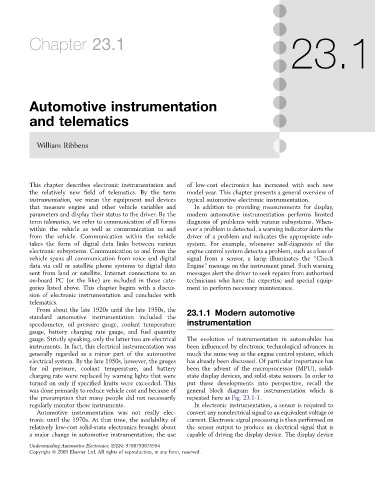Page 774 - Automotive Engineering Powertrain Chassis System and Vehicle Body
P. 774
23.1
Chapter 23.1
Automotive instrumentation
and telematics
William Ribbens
This chapter describes electronic instrumentation and of low-cost electronics has increased with each new
the relatively new field of telematics. By the term model year. This chapter presents a general overview of
instrumentation, we mean the equipment and devices typical automotive electronic instrumentation.
that measure engine and other vehicle variables and In addition to providing measurements for display,
parameters and display their status to the driver. By the modern automotive instrumentation performs limited
term telematics, we refer to communication of all forms diagnosis of problems with various subsystems. When-
within the vehicle as well as communication to and ever a problem is detected, a warning indicator alerts the
from the vehicle. Communication within the vehicle driver of a problem and indicates the appropriate sub-
takes the form of digital data links between various system. For example, whenever self-diagnosis of the
electronic subsystems. Communication to and from the engine control system detects a problem, such as a loss of
vehicle spans all communication from voice and digital signal from a sensor, a lamp illuminates the ‘‘Check
data via cell or satellite phone systems to digital data Engine’’ message on the instrument panel. Such warning
sent from land or satellite. Internet connections to an messages alert the driver to seek repairs from authorized
on-board PC (or the like) are included in those cate- technicians who have the expertise and special equip-
gories listed above. This chapter begins with a discus- ment to perform necessary maintenance.
sion of electronic instrumentation and concludes with
telematics.
From about the late 1920s until the late 1950s, the 23.1.1 Modern automotive
standard automotive instrumentation included the
speedometer, oil pressure gauge, coolant temperature instrumentation
gauge, battery charging rate gauge, and fuel quantity
gauge. Strictly speaking, only the latter two are electrical The evolution of instrumentation in automobiles has
instruments. In fact, this electrical instrumentation was been influenced by electronic technological advances in
generally regarded as a minor part of the automotive much the same way as the engine control system, which
electrical system. By the late 1950s, however, the gauges has already been discussed. Of particular importance has
for oil pressure, coolant temperature, and battery been the advent of the microprocessor (MPU), solid-
charging rate were replaced by warning lights that were state display devices, and solid-state sensors. In order to
turned on only if specified limits were exceeded. This put these developments into perspective, recall the
was done primarily to reduce vehicle cost and because of general block diagram for instrumentation which is
the presumption that many people did not necessarily repeated here as Fig. 23.1-1.
regularly monitor these instruments. In electronic instrumentation, a sensor is required to
Automotive instrumentation was not really elec- convert any nonelectrical signal to an equivalent voltage or
tronic until the 1970s. At that time, the availability of current. Electronic signal processing is then performed on
relatively low-cost solid-state electronics brought about the sensor output to produce an electrical signal that is
a major change in automotive instrumentation; the use capable of driving the display device. The display device
Understanding Automotive Electronics; ISBN: 9780750675994
Copyright Ó 2003 Elsevier Ltd; All rights of reproduction, in any form, reserved.

